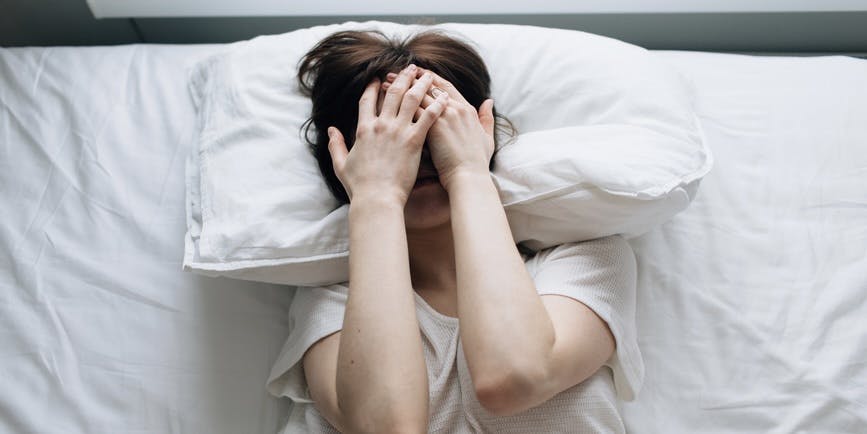
Why do I keep getting bacterial vaginosis (BV)?

Key Points:
- Bacterial vaginosis (BV) is a very common condition. It can cause an unpleasant fishy smell and thin, milky vaginal discharge. It’s caused by an imbalance of good and bad bacteria in the vagina.
- Bacterial vaginosis is treated with a course of antibiotics. Repeat cases of BV can be treated with another round of antibiotics. Or with other therapies in combination with antibiotics.
- A few things that help prevent BV include practicing safe sex, not douching and supporting your immune system.
Bacterial vaginosis (BV) is the most common vaginal condition in people assigned female at birth (AFAB) between the ages of 15-44. It’s caused by an imbalance of bacteria in the vagina.
Symptoms of bacterial vaginosis include a strong vaginal smell, vaginal itching and milky vaginal discharge.
As if BV symptoms aren’t bad enough, some people experience recurrent BV— BV that comes back after bacterial vaginosis treatment. More than 50% of such cases come back within 3-5 months. Sometimes, the same infection returns. Other times, a new infection hits home.
If you’ve experienced recurrent BV, don’t despair! Read on for a few reasons why your BV may come back. Plus, how you can get a BV prescription online through Dr. B’s virtual health platform.
What causes bacterial vaginosis?
Bacterial vaginosis is caused by an imbalance of good and bad bacteria in the vagina.
Bacterial vaginosis is not a sexually transmitted infection (STI). It’s not contagious. And it can't spread from person to person. But having sex does increase the risk of developing bacterial vaginosis.
The risk of developing BV also increases if you:
- Are pregnant
- Are using antibiotics
- Have unprotected sex
- Have an intrauterine device (IUD)
- Have multiple sex partners or a new sex partner
- Have a vagina and share sexual activity with people with vaginas
- Smoke cigarettes
Why you keep getting bacterial vaginosis
The reason bacterial vaginosis keeps coming back isn’t entirely clear. Antibiotics often clear out the bacteria that cause BV. But harmful bacteria can regrow if re-introduced from sex or other irritants.
Some researchers think that the bad bacteria can hide out in biofilms. These are groups of bacteria that stick together and make it hard for antibiotics to reach them. Biofilms may make it hard for BV pills and antibiotic creams to reach and clear harmful bacteria.
Sexual partners may play a part, too.
If you keep getting BV with the same partner, their genital chemistry may cause your vaginal irritation. Having your partner tested (and possibly treated) for BV may help. BV symptoms may lessen during treatment but still present. So finish your full course of BV treatment before having sex again.
What are some bacterial vaginosis treatment options?
Antibiotics are the first choice for treating bacterial vaginosis and usually work well. But up to 15% of people need a second course of treatment. Even when treated successfully, BV comes back for more than 50% of people within a few months.
Boric acid suppositories may be an option—especially when combined with antibiotics. Boric acid helps BV because it has antifungal and antibacterial properties that can lower the pH of the vagina. Boric acid suppository treatment isn’t right for every condition. So it should only be used under the direction of a medical provider.
Over-the-counter suppositories aren’t regulated by the FDA, making it impossible to know whether an individual product is safe. If you do have boric acid suppositories in the house, keep them out of the reach of children and pets. Boric acid is toxic if swallowed!
Chronic BV can be really frustrating. And BV doesn’t always cause symptoms. The only way to know you’ve cleared the infection is with a vaginal culture taken two weeks after completed treatment. A medical provider can help you find ways to treat BV online and prevent it from coming back.
How to prevent getting bacterial vaginosis again
People who get bacterial vaginosis over and over might need long-term antibiotics to help permanently clear up the infection. Lifestyle changes can prevent recurrent BV, too.
You can help prevent bacterial vaginosis by avoiding irritating products. These include douches, vaginal deodorants or sprays and scented tampons or pads used during a menstrual cycle. Wearing breathable cotton underwear can help, too, as bacteria grow best in warm, moist places.
Support your immune system with a healthy diet and lifestyle and don’t smoke. Smoking changes the way your body fights off infections. So it’s linked to higher rates of BV and STIs.
Online treatment for recurrent bacterial vaginosis
If you keep getting BV, you haven’t done anything wrong. If you have questions about recurrent BV, talk to a medical provider. They’ll help you review your current hygiene and sex habits to reduce your risk. And they’ll help you find a treatment to clear it up for good.
If you’re ready to discuss or find bacterial vaginosis treatment online, Dr. B can help.
Sources:
Abou Chacra, L., et al. (2022). Bacterial vaginosis: what do we currently know?. Frontiers in Cellular and Infection Microbiology.
Bautista, C.T., et al. (2016). Bacterial vaginosis: a synthesis of the literature on etiology, prevalence, risk factors, and relationship with chlamydia and gonorrhea infections. Military Medical Research.
Chen, R., et al. (2022). Probiotics are a good choice for the treatment of bacterial vaginosis: a meta-analysis of randomized controlled trial. Reproductive Health.
Centers for Disease Control and Prevention. (2022). Bacterial vaginosis - CDC basic fact sheet.
Goje, O. (2021). Bacterial vaginosis (BV) - gynecology and obstetrics. Merck Manuals Professional Edition.
Koumans, E.H., et al. (2007). The prevalence of bacterial vaginosis in the United States, 2001-2004; associations with symptoms, sexual behaviors, and reproductive health. Sexually Transmitted Diseases.
Leitich, H., et al. (2003). Bacterial vaginosis as a risk factor for preterm delivery: a meta-analysis. American Journal of Obstetrics and Gynecology.
Nelson, T. M., et al. (2018). Cigarette smoking is associated with an altered vaginal tract metabolomic profile. Scientific Reports.
Planned Parenthood. What is bacterial vaginosis? Symptoms, signs and causes.
Ravel, J., et al. (2021). Bacterial vaginosis and its association with infertility, endometritis, and pelvic inflammatory disease. American Journal of Obstetrics and Gynecology.
Surapaneni, S., et al. (2021). Recurrent bacterial vaginosis: an unmet therapeutic challenge. Experience with a combination pharmacotherapy long-term suppressive regimen. Sexually Transmitted Diseases.
Vodstrcil, L. A., et al. (2021). Bacterial vaginosis: drivers of recurrence and challenges and opportunities in partner treatment. BMC Medicine.
Sign up for the free Dr. B newsletter for a weekly report on the latest in healthcare + research-based advice for staying healthy and mentally well.
Related articles







